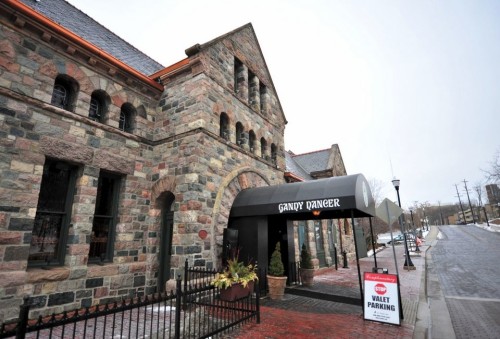From The Ann Arbor News:

Could the castle-like building that houses the Gandy Dancer restaurant in Ann Arbor return to its former glory as a rail depot?
That’s an idea the city and its consultants are now exploring at the request of the federal government.
Eli Cooper, the city’s transportation program manager, said the Federal Railroad Administration has asked the city’s project team to give further consideration to the historic Michigan Central Railroad Depot as a future train station option.
“They requested the same level of concept planning and cost estimation as the other sites remaining in the analysis,” Cooper said, referencing the fact that the city still is studying a site on Fuller Road and the existing Amtrak site on Depot Street.
“Our team has been busy crafting those concepts, costs and evaluating the implications of this alternative,” he said. “The work is ongoing.”
The Romanesque-style depot, built in 1886 and opened in 1887, was converted into the upscale seafood restaurant known as the Gandy Dancer around 1970.
The city has been exploring options for building a new train station for several years, citing concerns about the ability of the existing Amtrak station on Depot Street, immediately to the west of the Gandy Dancer, to handle growing passenger volumes. A new Amtrak station would replace the Amtrak station that was built in 1983.
The city moved forward on a study of potential sites for a new station in 2014, narrowing the list to two: the existing Amtrak site, and a piece of Fuller Park in front of the University of Michigan Hospital along Fuller Road.
If the existing Amtrak site is redeveloped, the city’s project team already is considering the possibility of using a portion of the old MichCon property that DTE Energy owns across the tracks as part of the new station’s footprint.
But as the city and its consultants continue evaluating the existing Amtrak site and the Fuller Road site, the FRA is now requesting additional details in the evaluation of the potential use of the historic Michigan Central Railroad Depot building.
Cooper notes the project team already included study of the Gandy Dancer location as part of the environmental review process.
“We submitted materials to the FRA including information about the (Gandy Dancer) site,” he said. “The FRA requested we continue to evaluate this location as part of the environmental review. They asked that we develop concept plans and costs associated with use of the (Gandy Dancer) as one of the alternatives.”
The city has hired consultant URS Corp. for $824,875 to lead the new train station study. A little less than $165,000 is coming from funds the city previously budgeted, with the rest covered by a federal rail grant the city accepted in 2012.
The $2.8 million federal rail planning grant also is expected to cover some additional future expenses if the project moves forward.
Final design of a new Amtrak station is identified as a $2.6 million expense in 2016-17 in the city’s Capital Improvement Plan. The actual construction of the new station is shown as a separate $44.5 million line item in 2017-18.
City officials expect 80 percent of the funding to come from the federal government with other local partners potentially contributing funds. Ann Arbor residents get to vote on the project before any construction happens.
Managers at the Gandy Dancer referred requests for comment to the restaurant’s corporate owner, Landry’s Inc., which did not respond.
City Council Member Sabra Briere, D-1st Ward, said she’s fascinated by the idea of having the Gandy Dancer building become the city’s train station again.
“I’m intrigued by it,” she said. “I don’t know what motivated the federal government to ask for this, but if this is the decision that gets made, if the owner of the property is willing to make the sale, I’d be OK with it. It’s a fine building.”
She said she’s surprised by the idea, since the property is privately owned. She said it’s not yet clear whether the city or the federal government would buy it.
“What I really like about using that building is it is a landmark,” she said. “We talk about wanting a gateway building to the city. Well, there it is. It’s already there.”
When the new Michigan Central Railroad Depot opened in 1887, boosters described it as the finest on the line between Buffalo and Chicago.
The depot served as the gateway to Ann Arbor at a time when trains were the major means of intercity travel. More than a dozen trains a day brought freight, as well as crowds of visitors, business people, entertainers and students.
“The central building had ornate waiting rooms, an elaborate ticket booth, coffered wood ceilings, stained glass windows, and a large terra-cotta fireplace,” reads a historic marker near the site, noting there was a garden with a fountain.
“Enthusiastic crowds came to see presidents, prominent politicians, and visiting dignitaries, some of whom spoke from the rear platform of the train,” the marker reads, noting some arrived in private railway cars.
“Patriotic fanfare and emotional farewells sent troops off to war. U-M football teams departed and returned to mobs of cheering fans.”
One of the images on the marker shows Richard Nixon, then running mate of presidential candidate Dwight Eisenhower, addressing a crowd from a train in 1952.
In 1969, the station sold and was converted into the Gandy Dancer. The former express office served as the depot until today’s Amtrak station was built in 1983.
Source: http://www.mlive.com/news/ann-arbor/index.ssf/2015/02/back_to_the_future_could_the_g.html
